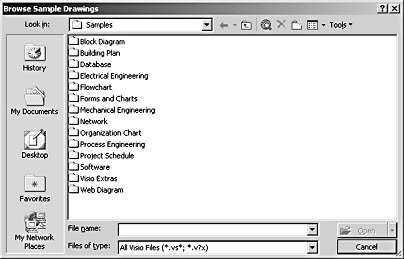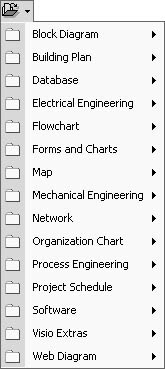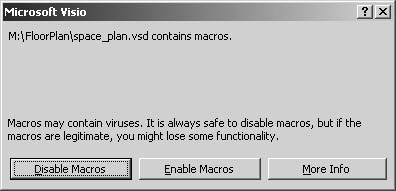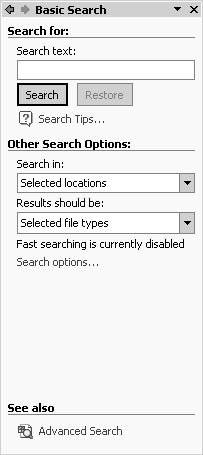Opening Visio Documents
3 4
In Visio, you can open diagrams, stencils, templates, and workspace files. Each is represented by a different file extension:
- VSD is a Visio drawing file.
- VSS is a Visio stencil file.
- VST is a Visio template file.
- VSW is a Visio workspace file.
Most of the time, you use the Open command or toolbar button to open a drawing file (.vsd). This section focuses on different ways to open diagrams.
For details about opening and saving Visio files in XML format, see "Visio and XML File Formats."
Opening an Existing Diagram
Now that Visio includes the same Open dialog box as Microsoft Office (see Figure 1-17), with the Places bar of shortcuts, you can quickly locate frequently used folders and documents. Not only can Visio 2002 open documents created in Visio 2000, Visio 2000 can open diagrams created in Visio 2002. Visio 2002 can open diagrams created in any earlier version of Visio.

Figure 1-17. Visio includes the same Open dialog box as other Microsoft Office XP programs.
To open an existing drawing file:
- Click the Open button on the Standard toolbar to display the Open dialog box. You can instead choose File, Open or press Ctrl+O.
- In the Look In list, open the folder that contains the file or files you want to open. Visio displays the folder's contents.
- Click a file to select it. To open more than one drawing file, press Ctrl and then click the files you want.
- Click Open.
Opening a Recently Used Diagram
The quick way to find a diagram you worked on recently is to look on the File menu, which lists the most recently opened diagrams at the bottom of the menu. Click the file name to open the diagram. You can also use the New Drawing task pane to locate recently opened files. This is a good technique to use when you're starting Visio, because the Choose Drawing Type pane appears with the New Drawing task pane. If you're working in Visio and want to display it, choose File, New, Choose Drawing Type. In the New Drawing task pane, you'll see the diagrams you've worked on under the Open A Drawing heading. If you don't see the drawing you want listed, click More Drawings. Visio displays the Open dialog box, so you can locate the file you want.
Opening Another Visio File Type
Besides drawing files, Visio can open stencils, templates, workspaces, and files in other formats as well. Choose File, Open. The key is to use the Files Of Type drop-down list that appears at the bottom of the Open dialog box. Click the drop-down arrow to display a list of the types of files that Visio can open. Select a file format. Then, in the Look In list, open the folder that contains the file you want to open. Only the files of the type you selected are displayed, making it easy to locate and select the one you want. Then click Open.
Opening a Sample File
Visio includes a sample of every type of drawing and diagram that you can create. You can use the sample files merely as inspiration, or edit them and save them as a new diagram. To browse the list of sample files, click File, New, Browse Sample Drawings. Visio displays a dialog box that looks just like the Open dialog box, except that it displays sample file folders, as Figure 1-18 shows. Double-click a folder to display the samples for that diagram type. For example, double-click Flowchart to display the list of sample flowchart diagrams.

Figure 1-18. Visio includes a sample drawing file for many diagram types.
Tip
By default, Visio stores its sample files in C:\Program Files\Microsoft Office\Visio10\1033\Samples.
Opening a New Drawing File Without a Template
You can open a new Visio drawing file that's not based on a template. Visio creates a new diagram with a blank drawing page and the default page settings for unscaled drawings. It's like starting with a fresh slate. No stencils are opened, but you can add them later. To do this, click Ctrl+N, or choose File, New, New Drawing.
Opening Stencils
When you want to work with more shapes, you can open additional stencils. There's a practical limit to the number of stencils you can open, although it depends on your screen resolution. The screen can become pretty crowded with more than about seven stencils, and it gets a little tougher to find the particular shape you want. However, you can open as many stencils as you need. The easiest way is to use the Open Stencil button on the Standard toolbar. It does one of two things:
- If you click the button itself, the Open Stencil dialog box appears.
- If you click the drop-down arrow on the button, a menu of diagram types appears, and you can point to a type to display its stencils, as Figure 1-19 shows.

Figure 1-19. The quickest way to open another stencil is with the Open Stencil button on the Standard toolbar.
If you prefer working with menus, choose File, Stencils, Open Stencil to display the Open Stencil dialog box, where you can locate any stencil, including ones you create.
InsideOut
If you create your own stencils, they will appear on Visio's stencil lists in the Open Stencil button and dialog box if you save them in the right folder. Visio automatically looks for stencil (.vss) files in the C:\Program Files\Microsoft Office\Visio10\1033\Solutions folder and its subfolders.
For details about creating stencils, see "Saving Customized Shapes as Masters." For details about opening stencils for editing, see "Opening Stencil (.vss) Files."
Opening Older Versions of Microsoft Visio Files
You can open files created in any previous version of Microsoft Visio Standard, Visio Professional, Visio Technical, or Visio Enterprise, including Visio 1, 2, 3, 4.x, 5.x, or 2000. To do this, choose File, Open, locate the drawing file you want to open, and then click Open.
newfeature! Another great new feature is that any drawing file you create with Visio 2002 can be opened by other Visio users—regardless of the version of Visio they have. They may not be able to see every drawing element, however. For example, Visio 5 and earlier does not include many of the windows on the View menu, such as the Pan & Zoom window.
Tip
If you use Windows Explorer to locate a Visio drawing file (.vsd) created in an older version of the product, you can double-click the file name. Visio 2002 automatically opens with the old drawing.
Troubleshooting
Opening a Visio drawing file causes a message about macros to appear.
When you open a drawing file that includes a VBA macro or other programming code, Visio displays a message to warn you about its contents, as Figure 1-20 shows. Usually the macros are needed to enable interactive features of the drawing. This message is a new safeguard feature of Visio. If you know that the drawing file came from a reputable source, click Enable Macros. Visio probably requires the macro to run the built-in shape intelligence.

Figure 1-20. If you open a Visio drawing file that includes a built-in macro, as many Visio drawings and templates do, this message appears.
If you frequently open drawing files created in older versions of Visio, you may want to disable the message. This requires lowering your security settings. To do this, click Tools, Macros, Security, and then select the Low security option.
Searching for a File to Open
The task pane includes a powerful search tool that you can use to find the files or folders you need without leaving your Visio diagram. You can locate text in a document and find files or folders, regardless of where they are stored—your local hard disk, a network folder, or in Microsoft Outlook. Like many Web search engines, the task pane includes a Basic Search and an Advanced Search. To display the task pane, click View, Task Pane. The task pane's Basic Search options appear as Figure 1-21 shows.

Figure 1-21. The task pane (View, Task Pane) helps you locate documents based on the text they contain.
Tip - Switch Between New Drawing and Search Task Pane
If you display the task pane and the New Drawing options appear, click the drop-down arrow on the title bar, and then select Search. This is a fast way to switch between options for searching and opening drawings.
You can do the following:
- In the Search Text box, type one or more words—text in the document, keywords, or other file properties. Use an asterisk character (*) to replace groups of characters and a question mark (?) to replace a single character. Click Search Tips for help.
Tip
The more words you type in the Search Text box, the more specific your search results will be. - In the Search In box, tell Visio where to look. If you know which folder, you can type it in the Search In box. Otherwise, click a plus sign (+) to expand the list, and click to place a check mark beside the folder at the highest level you want to search. You can click a check box several times—with each click, the selection changes. A second click selects a folder and all folders within it. A third click cancels the top selection but retains the folders. A fourth click cancels the entire selection, folders and all.
- In the Results Should Be box, you can narrow the scope of the search to locate only files of a particular type.
When you click the Search button, Visio begins the hunt and displays the Search Results. To return to the Basic Search task pane, click the Modify Button. To refine the search criteria, click the Advanced Search option at the bottom of the Basic Search pane.
Opening a File in a Document Management System
If you work with a document management system (DMS) that supports the Open Document Management API (ODMA) standard, you can retrieve and store Visio drawings and diagrams with it. If Visio detects the presence of an ODMA 1.5–compliant system on your computer, you can choose File, Open to open your drawing file, and the DMS Open dialog box appears instead of the Open dialog box. If you use another method of opening your file, such as pressing Ctrl+O, you won't be able to save to the document management system. If the DMS Open dialog box does not appear, you may need to register Visio with your document management system. Refer to the documentation that came with your document management system.
EAN: 2147483647
Pages: 211